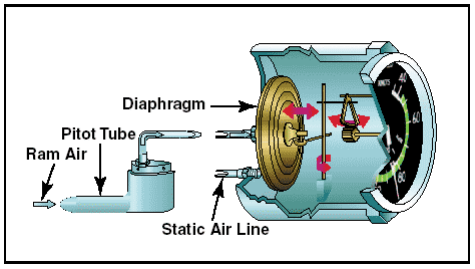¶ Mechanism
The airspeed indicator (ASI) displays the speed at which the airplane is moving through the air.
The airspeed indicator is a sensitive differential pressure gauge which measures and shows the difference between impact pressure from Pitot tube, and static pressure from static line (the undisturbed atmospheric pressure at current flight level).

These two pressures will be equal when the airplane is parked on the ground in calm air.
When the airplane moves through the air, the pressure on the pitot line becomes greater than the pressure in the static lines.
This difference in pressure is registered by the airspeed pointer on the face of the instrument, which is calibrated in miles per hour, knots, or both.
Manufacturers use this airspeed as the basis for determining airplane performance.
¶ Aspect
¶ Light single-engine aircrafts
The direct instrument reading from the airspeed indicator give an airspeed uncorrected for variations in atmospheric density, installation error, or instrument error.

The altimeter displays also other speed information:
- White arc: This arc is commonly referred to as the flap operating range since its lower limit represents the full flap stall speed and its upper limit provides the maximum flap speed (Approaches and landings are usually flown at speeds within the white arc.
- Green arc: This is the normal operating range of the airplane. Most flying occurs within this range.
- Yellow arc: Caution range. Fly within this range only in smooth air, and then, only with caution.
- Red line (VNE): Never exceed speed. Operating above this speed is prohibited since it may result in damage or structural failure.
- Lower limit of white arc (VS0): The stalling speed or the minimum steady flight speed in the landing configuration. In small airplanes, this is the power-off stall speed at the maximum landing weight in the landing configuration (gear and flaps down).
- Upper limit of the white arc (VFE): The maximum speed with the flaps extended.
- Lower limit of green arc (VS1g): The stalling speed or the minimum steady flight speed obtained in a specified configuration. For most airplanes, this is the power-off stall speed at the maximum takeoff weight in the clean configuration (gear up, if retractable, and flaps up).
- Upper limit of green arc (VNO): The maximum structural cruising speed. Do not exceed this speed except in smooth air.
¶ Light twin-engine aircrafts
Two more information appear on light twin-engine aircrafts:
- Single engine best climb airspeed (VYSE): The airspeed which must be used for any climb whenever the aircraft is flown with one engine inoperative.
- Minimum Airborne Control Speed (VMCA): The lowest airspeed at which the aircraft stalls on the yaw axis whenever the aircraft is flown with one engine inoperative.
- None
- VID 150259 - Creation
- VID 200696 - Wiki integration
- VID 496402 - Wiki.js integration